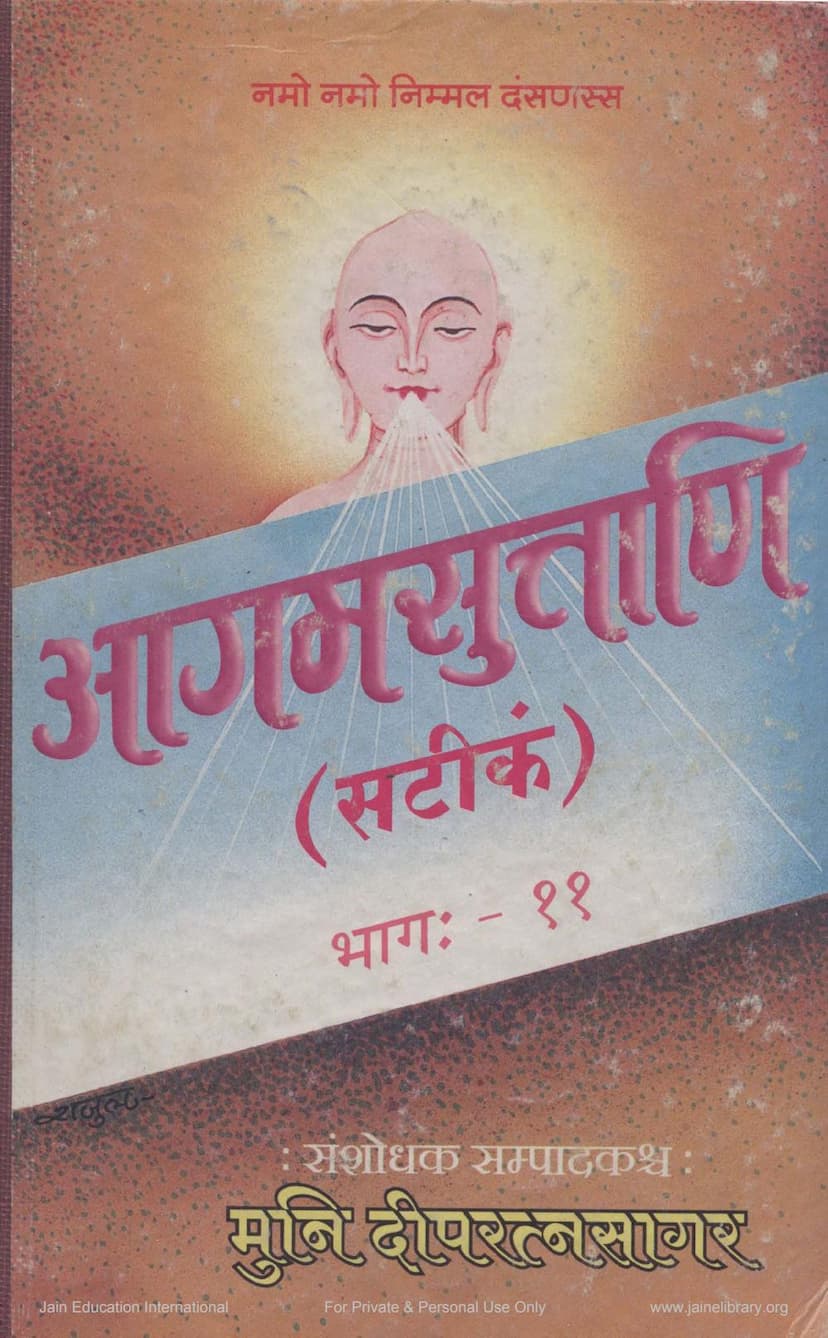Agam Suttani Satikam Part 11 Pragnapana
Added to library: September 1, 2025

Summary
The provided text is the eleventh part (Bhag-11) of the "Agam Suttani Satikam" series, titled "Prajnapana (Upaanga Sutra-2)". This book is a commentary on the Prajnapana Upaanga Sutra, with the original sutra compiled by Shyamaacharya and the commentary (vritti) authored by Malayagiri Acharya. The series is edited and researched by Muni Deepratnasagar.
Here's a comprehensive summary of the content of this volume, based on the provided text which includes introductory pages and the beginning of the commentary on the fifteenth Pada (chapter) of the Prajnapana Sutra:
Overall Context:
- Agam Suttani Satikam (Bhag-11): Prajnapana Upaanga Sutra-2 is the eleventh volume in a series that provides detailed commentaries on Jain Agamic scriptures.
- Prajnapana Upaanga Sutra: This is the second part of the Prajnapana Upaanga Sutra, following the first part which covered Padas 1-14. This volume covers Padas 15-36.
- Commentary: The text includes the original sutra and the detailed commentary (vritti) by Malayagiri Acharya.
- Research and Editing: Muni Deepratnasagar is credited with researching and editing this volume.
- Publisher: Agam Shrut Prakashan.
Content Summary (Specifically focusing on the beginning of Pada 15):
The provided text focuses on the initial part of Pada 15: Indriya (Sense Organs), which is the fifteenth chapter of the Prajnapana Upaanga Sutra. The commentary begins by explaining the purpose of this chapter:
- Purpose of Discussing Sense Organs: After discussing karmic results and intense kashaya (passions) in the previous section (which led to special mention of bondage factors), this chapter will specifically detail the results and characteristics of the sense organs (Indriyas). It begins with the general existence of sense organs and then delves into their specific attributes.
- Structure of Pada 15: The commentary indicates that Pada 15 is divided into two "Uddeshakas" (sections or sub-chapters).
- First Uddeshaka (Uddeshaka-1): This section will cover various aspects of the sense organs, including their:
- Form (Samsthana): The specific shape or form of each sense organ.
- Thickness (Bahalya): The width or breadth of the sense organs.
- Extent/Pervasiveness (Pohatta): How far or spread out each sense organ is.
- Number of Pradeshas (Kati-pradesha): How many constituent parts or pradeshas each sense organ has.
- Avagahana (Extent of Perception/Coverage): The spatial extent covered by the sense organs.
- Subtlety/Grossness (Sukshma): The subtle or gross nature of the sense organs.
- Qualities (Guna): The inherent qualities like hardness, lightness, etc., of the sense organs.
- Comparisons (Alpa-bahutva): Comparisons of the sense organs in terms of these attributes.
- Specific Topics: The commentary mentions that the sutras will cover areas like the body, yoga, feeling (Veda), passion (Kashaya), determination (Samyaktva), knowledge, perception, restraint, usage, and food, along with details about the twelve categories (Dvadashadhikara). The text also lists specific topics like the six types of leśya, their derivations, and their relation to rebirth (upapāta).
- The text then elaborates on the structure of the first Uddeshaka, listing several specific aspects to be covered: Shape, thickness, extent, number of pradeshas, avagahana, subtlety, grossness, qualities (hard/light), comparisons, touching/non-touching, entry/non-entry, scope of perception, gurus (teachers), food, location (Lok/Alok), etc.
- The commentary then begins the detailed explanation:
- Number of Sense Organs: It's established that there are five sense organs (Pancha Indriya).
- Names: Hearing organ (Sotindriya), Eye organ (Chakshuridriya), Nose organ (Ghanindriya), Tongue organ (Jihvindriya), Touch organ (Phasindriya).
- Shape (Samsthana):
- Hearing organ: Like a Kadamba flower.
- Eye organ: Like a lentil seed (Masoor).
- Nose organ: Like an Aimukta flower.
- Tongue organ: Like a Khura (part of a plough or a sharp blade).
- Touch organ: Various shapes (Nana-samsthana).
- Thickness (Bahalya): The hearing organ has a thickness of an infinitesimal part of a finger-width. This is stated to be similar for all sense organs up to the touch organ.
- Extent (Pohatta): The hearing organ's extent is also an infinitesimal part of a finger-width. The eye and nose organs are similar. The tongue organ's extent is a finger-width. The touch organ's extent is the size of the entire body.
- Number of Pradeshas (Kati-pradesha): The hearing organ has infinite pradeshas. This is stated to be similar for all sense organs up to the touch organ.
- Avagahana (Extent of Perception/Coverage): This section begins comparing the avagahana (coverage) and pradesha (constituent parts) of the sense organs, establishing a hierarchy of magnitude.
- Qualities: The text then discusses qualities like harshness/gravity (kakshada/guruta) and softness/lightness (mridu/laghu), stating that the touch organ has infinite of both, while the others have varying degrees. The eye organ has the least harshness/gravity, followed by others in increasing order, and similarly for softness/lightness.
- First Uddeshaka (Uddeshaka-1): This section will cover various aspects of the sense organs, including their:
The text then proceeds to detail these characteristics for various categories of beings, including Narakas (hell beings), Asura Kumars, and elemental beings (Prithvi Kayika, Ap Kayika, etc.), highlighting differences in their sense organs based on their forms, structures, and existence.
Key Themes and Concepts Introduced:
- Indriyas (Sense Organs): The fundamental nature, form, extent, and number of pradeshas of the five sense organs are being systematically described.
- Classification of beings: The text categorizes beings according to their lifespan, consciousness, and sensory capabilities, applying the descriptions of sense organs to these categories.
- Jiva (Soul/Living Being): The discussion is always in the context of how these attributes apply to the soul or living being in different states and forms.
- Commentary Style: The commentary provides detailed explanations, references to linguistic rules (like 'Prachana'), and justifications for specific terminologies or classifications.
The volume clearly aims to provide a very systematic and detailed analysis of the sense organs within the Jain cosmological and philosophical framework as presented in the Prajnapana Sutra.